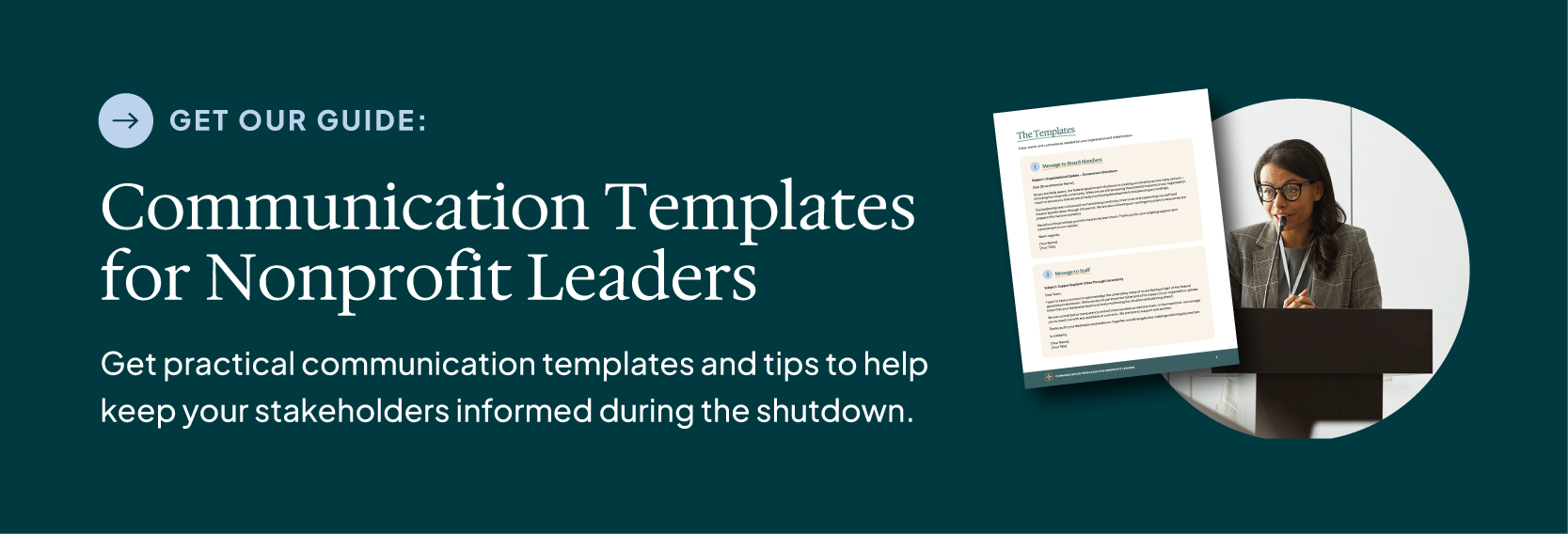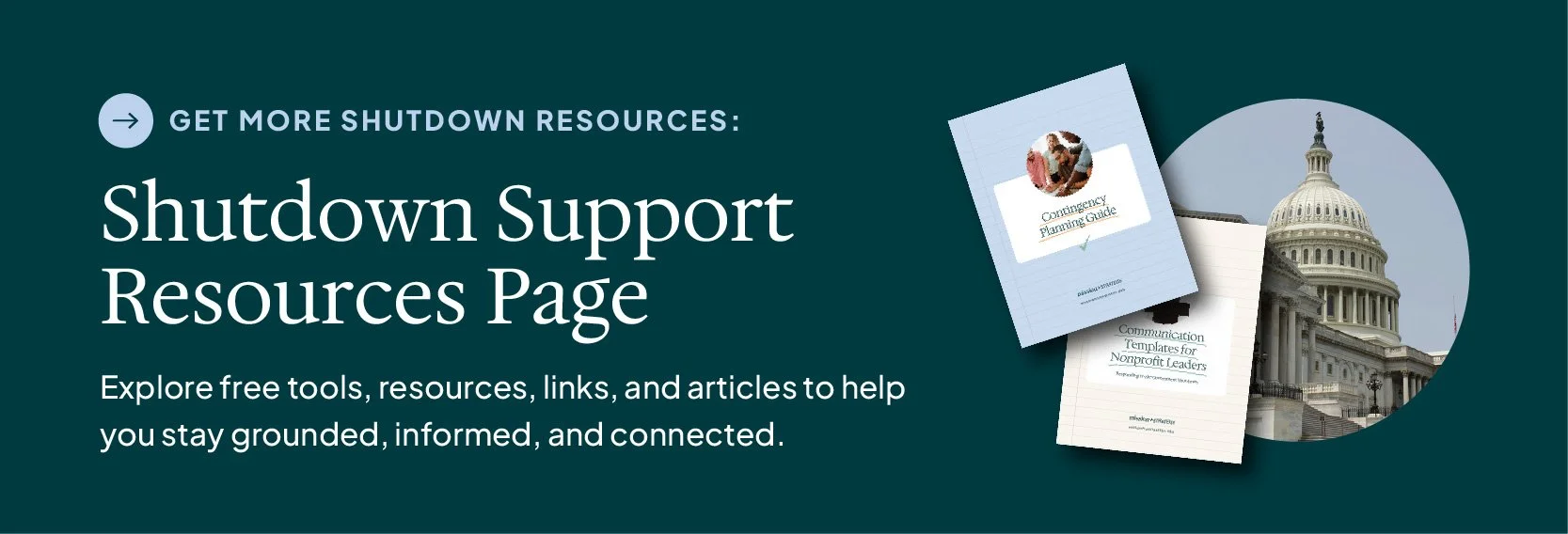What Nonprofits Can Do During a Government Shutdown (and What We’ve Learned from Past Crises)
by Judie Caribeaux, Chief Collaborations Officer
Government shutdowns can create more than uncertainty and chaos – they bring fear, added workload, and a sense of giving up because there is a quick succession of powerful waves that crash you against the rocks, yet again. In these conditions, it is hard to stay focused on the strategic vision you have set. These moments test both your organization’s resilience as well as your leadership and ability to adapt under pressure.
Here are four key actions to consider—plus lessons from the 2015 - 2017 Illinois budget impasse and the COVID-19 pandemic.
Know Your Monthly “Run Rate”
Your monthly run rate is your organization’s total expenses each month. While revenue is equally important, it’s often more cyclical and less predictable than expenses, so understanding your baseline costs is critical. In addition, know how many days of cash you have on hand at any given time – this metric tells you how long you can continue to operate if there was not additional income.
Review your organization’s cash flow and think about working both sides of the equation: Income and expenses. On the income side, identify alternative funding sources. On the income side, determine how long you can operate without federal payments, identify alternative funding sources, explore bridge financing options, use reserves, or private grants to maintain stability. On the expense side, consider renegotiating rent payments, loans, or vendor contracts to help reduce your run rate.
We recommend using a simple cash flow stress test to anticipate when you might run out of cash. Here is a link to download ours.
Lesson:
During the 2015–2017 Illinois state budget impasse, many nonprofits were forced to cut programs or close because they lacked reserves or access to lines of credit. Similarly, during the pandemic, organizations with strong liquidity and diversified revenue streams were better able to adapt and survive.
As the Executive Director of a domestic violence agency during the nearly two-year state budget impasse, I learned the value of acting early – and it starts with knowing your run rated and days of cash on hand. Because we understood our baseline expenses and cash position, we could make informed decision quickly. We immediately reduced costs by eliminating a few senior level administrative positions and freezing non-essential hiring, while protecting essential direct service staff. No one knew the impasse would last two years, but those early decisions compounded savings over time and kept our doors open.
Communicate, Communicate, Communicate
Transparency builds trust. Keep staff, clients, and partners informed about potential changes in service delivery, funding status, and organizational priorities. Clear, consistent communication reduces anxiety and helps everyone stay aligned.
Your tone sets the tone for the organization. If you remain calm and confident, your staff will follow your lead. Silence, however, creates a vacuum—and in the absence of information, people will fill that gap with assumptions or rumors, often inaccurate and damaging. Once those stories take hold, you’ll face the uphill battle of not only sharing the truth but also undoing false narratives.
Proactive communication is key:
Share what you know and what you don’t know yet.
Provide regular updates, even if there’s no new information.
Make sure your board and leadership team are aligned on messaging before it goes out.
Lesson:
During both the Illinois budget impasse and COVID-19, we made consistent communication a priority with staff, board members, donors, and key community partners. Each week, we sent email updates to staff and board and several times a month we created and sent video messages to convey a calm and confident presence. We also highlighted stories of client impact and resilience, which were further shared in the community to inspire and strengthen support. Even when there wasn’t much new information, we recognized that regular communication was essential to sustain relationship and building trust – showing we were aware, engaged, and actively managing the crisis response. At a time when many felt isolated, these efforts help people feel connected and informed.
Elevate Your Voice
Track the impact of the government shutdown on your organization and those you serve. Data and stories together make a powerful case: numbers demonstrate scale, while stories illustrate the human impact behind the numbers. Keep a simple record of reduced services, waitlists, staff layoffs or furloughs, increased demand. This not only informs your board and funders, it also provides evidence you need for advocacy.
Continue to build relationships with your elected officials at the federal and state levels. Board members are your “secret sauce” to help build these relationships. Since they volunteer their time to help lead the organization, legislators want to know why this work is so important. Board members give their time, money and talent to support your work – they are all in in many ways others are not.
Your goal is not only to raise awareness but also to be seen as the go-to source of information about what’s happening in your sector. Policymakers, funders, and community leaders are all looking for clear, credible accounts of the shutdown’s impact. If they know they can count on you for accurate, timely updates, you strengthen your organization’s influence and the sector’s collective voice.
Lesson:
Scheduling group meetings with legislators proved nearly impossible, so we invited them individually to tour the shelter. Because our shelter spaces were private and confidential, we converted an office into a model room so legislators, donors, and even potential clients could see what the space was like—inviting and comfortable. Long before the budget impasse, we had already built these relationships: sending client notes about the impact of our services, assigning board members to send congratulatory messages after re-elections, and calling to thank legislators when they supported key bills. By the time the crisis hit, they knew who we were—not only as advocates, but as a trusted resource when their constituents needed help.
Care for Your People
Crises don’t just strain finances—they take a toll on the mental health of staff, volunteers, and clients. It is easy to feel defeated when you’re being marginalized, scapegoated, or “othered.” Nonprofit work is difficult under the best of circumstances, and moments like a shutdown make it even more challenging.
Many times, our clients “borrow” the ability to emotionally regulate from staff until they can build that capacity on their own. While this is an essential part of the healing process, it can be draining for staff who are constantly carrying the weight of other people’s emotions. Layer on top of that the stress of wondering, Will I still have a job? Is there enough money coming in to keep the lights on? We want to grow to meet the demand, but right now the best we can do is survive. The emotional load becomes heavier than the financial one. Leaders must be intentional about creating space for resilience, restoration, and connection so staff and volunteers don’t reach the breaking point.
Lesson:
During COVID-19, we began every meeting with simple check-ins, giving people a chance to share how they were doing before moving into the work. During the Illinois budget impasse, our leadership team gathered every Friday afternoon—not to problem-solve, but to celebrate small successes from the week. I kept their favorite sodas and candies on hand, and those moments of celebration built camaraderie and helped counter feelings of despair.
Sometimes the most important act is to notice when someone is losing hope and to reach out. Small gestures of care—listening, checking in, acknowledging wins—remind people they are not alone. In moments of crisis, action is the best antidote to hopelessness. When staff and volunteers feel seen, supported, and connected, they are far more able to carry out the mission under pressure. Investing in their well-being is not a distraction from the work—it is the work.
Together, we are stronger.
If you need support in navigating uncertainty or balancing your mission and business strategies, we’re here to help.
Mission + Strategy is an invested thought partner to your nonprofit organization. Through our Strategic Advising, Mergers & Partnerships, and Shared Back Office service solutions, we help nonprofits achieve alignment between their mission and business strategies.












